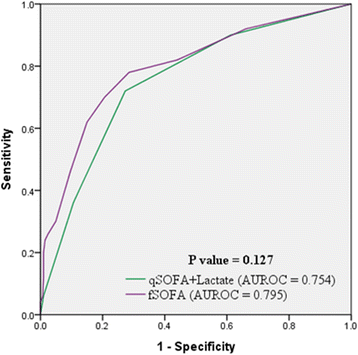Addition of lactic acid levels improves the accuracy of quick sequential organ failure assessment in predicting mortality in surgical patients with complicated intra-abdominal infections: a retrospective study
- PMID: 29563963
- PMCID: PMC5851244
- DOI: 10.1186/s13017-018-0173-6
Addition of lactic acid levels improves the accuracy of quick sequential organ failure assessment in predicting mortality in surgical patients with complicated intra-abdominal infections: a retrospective study
Abstract
Background: The quick sequential organ failure assessment (qSOFA) alone has a poor sensitivity for predicting mortality in patients with complicated intra-abdominal infections, and plasma lactate levels have been shown to have a strong association with mortality in critically ill patients. Therefore, this study aimed to compare the performance of qSOFA with a score derived from a combination of qSOFA and serum lactate levels for predicting mortality in surgical patients with complicated intra-abdominal infections.
Methods: This retrospective study was performed at a university hospital. The medical records of 457 patients who presented to the emergency department (ED) between January 2008 and December 2016 and required emergency gastrointestinal surgery for a complicated intra-abdominal infection were reviewed retrospectively. qSOFA criteria, sequential organ failure assessment (SOFA) scores, and plasma lactate levels during their ED stay were collected. We performed area under receiver operating characteristic (AUROC) curve and sensitivity analysis to compare the performance of qSOFA alone with that of a score derived from the use of a combination of the qSOFA and lactate levels for predicting patient mortality.
Results: Fifty patients (10.9%) died during hospitalization. The combined qSOFA and lactate level score was superior to qSOFA alone (AUROC = 0.754 vs. 0.717, p = 0.039, respectively) and comparable to the full SOFA score (AUROC = 0.754 vs. 0.795, p = 0.127, respectively) in predicting mortality. Sensitivity and specificity of qSOFA alone were 46 and 86%, respectively, and those of the combined score were 72 and 73%, respectively (p < 0.001).
Conclusion: A score derived from the qSOFA and serum lactate levels had better predictive performance with higher sensitivity than the qSOFA alone in predicting mortality in patients with complicated intra-abdominal infections and had a comparable predictive performance to that of the full SOFA score.
Keywords: Intra-abdominal infection; Lactate; Mortality; Retrospective studies.
Conflict of interest statement
This study was approved by the Institutional Review Board (4-2017-0726).Not applicableThe authors declare that they have no competing interests.Springer Nature remains neutral with regard to jurisdictional claims in published maps and institutional affiliations.
Figures


Similar articles
-
Prognostic accuracy of the quick Sequential Organ Failure Assessment (qSOFA)-lactate criteria for mortality in adults with suspected bacterial infection in the emergency department of a hospital with limited resources.Emerg Med J. 2020 Jun;37(6):363-369. doi: 10.1136/emermed-2018-208361. Epub 2020 Apr 21. Emerg Med J. 2020. PMID: 32317296
-
A combination of C-reactive protein and quick sequential organ failure assessment (qSOFA) score has better prognostic accuracy than qSOFA alone in patients with complicated intra-abdominal infections.Acta Chir Belg. 2020 Dec;120(6):396-400. doi: 10.1080/00015458.2019.1642579. Epub 2019 Jul 16. Acta Chir Belg. 2020. PMID: 31307292
-
The Combined SIRS + qSOFA (qSIRS) Score is More Accurate Than qSOFA Alone in Predicting Mortality in Patients with Surgical Sepsis in an LMIC Emergency Department.World J Surg. 2020 Jan;44(1):21-29. doi: 10.1007/s00268-019-05181-x. World J Surg. 2020. PMID: 31641836
-
Head-to-head comparison of qSOFA and SIRS criteria in predicting the mortality of infected patients in the emergency department: a meta-analysis.Scand J Trauma Resusc Emerg Med. 2018 Jul 11;26(1):56. doi: 10.1186/s13049-018-0527-9. Scand J Trauma Resusc Emerg Med. 2018. PMID: 29996880 Free PMC article. Review.
-
Accuracy of quick Sequential Organ Failure Assessment (qSOFA) score and systemic inflammatory response syndrome (SIRS) criteria for predicting mortality in hospitalized patients with suspected infection: a meta-analysis of observational studies.Clin Microbiol Infect. 2018 Nov;24(11):1123-1129. doi: 10.1016/j.cmi.2018.03.032. Epub 2018 Mar 29. Clin Microbiol Infect. 2018. PMID: 29605565
Cited by
-
Intraoperative serum lactate levels as a prognostic predictor of outcome for emergency abdominal surgery: a retrospective study.BMC Surg. 2023 Jun 16;23(1):162. doi: 10.1186/s12893-023-02075-7. BMC Surg. 2023. PMID: 37328824 Free PMC article.
-
Lactate-enhanced-qSOFA (LqSOFA) score as a predictor of in-hospital mortality in patients with sepsis: systematic review and meta-analysis.Eur J Trauma Emerg Surg. 2025 Jan 24;51(1):33. doi: 10.1007/s00068-024-02757-8. Eur J Trauma Emerg Surg. 2025. PMID: 39853387
-
Head-to-head comparison of pre-hospital qSOFA and lactate-qSOFA for predicting sepsis in patients with and without suspected infection. A multicenter prospective cohort study.Arch Med Sci. 2020 Feb 12;20(5):1547-1555. doi: 10.5114/aoms.2020.92901. eCollection 2024. Arch Med Sci. 2020. PMID: 39649288 Free PMC article.
-
Pre and postoperative lactate levels and lactate clearance in predicting in-hospital mortality after surgery for gastrointestinal perforation.BMC Surg. 2022 Mar 9;22(1):93. doi: 10.1186/s12893-022-01479-1. BMC Surg. 2022. PMID: 35264127 Free PMC article.
-
Prehospital qSOFA, mSOFA, and NEWS2 performance for sepsis prediction: A prospective, multi-center, cohort study.Front Med (Lausanne). 2023 Apr 18;10:1149736. doi: 10.3389/fmed.2023.1149736. eCollection 2023. Front Med (Lausanne). 2023. PMID: 37144037 Free PMC article.
References
-
- Bone RC, Balk RA, Cerra FB, et al. Definitions for sepsis and organ failure and guidelines for the use of innovative therapies in sepsis. The ACCP/SCCM Consensus Conference Committee. American College of Chest Physicians/Society of Critical Care Medicine. Chest. 1992;101:1644–1655. doi: 10.1378/chest.101.6.1644. - DOI - PubMed
MeSH terms
Substances
LinkOut - more resources
Full Text Sources
Other Literature Sources

